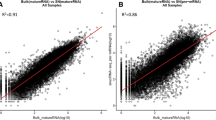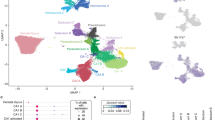Abstract
Background
Down syndrome (DS), the most frequently occurring human chromosomal disorder, is caused by trisomy 21. The exact molecular effects of trisomy on certain cell populations in the brain remain poorly understood.
Objective
The purpose of this study was to investigate the effects of trisomy on the transcriptomes of various types of neurons and nonneuronal cells in the hippocampus.
Methods
A total of 8993 nuclei from the WT and 6445 nuclei from the Dp16 hippocampus were analyzed by single-nucleus RNA sequencing (snRNA-seq). Cell clustering was achieved by the Seurat program.
Results
Hippocampal cells were grouped into multiple neuronal and nonneuronal populations. Only a limited number of trisomic genes were upregulated (q < 0.001) over 1.25-fold in a specific type of hippocampal cell. Specifically, deregulation of genes associated with synaptic signaling and organization was observed in multiple cell populations, including excitatory neurons, oligodendrocytes, and microglia. This observation suggests the potential importance of synapse deficits in DS. Interestingly, GO annotation of the upregulated genes suggested potential activation of the immune system by hippocampal excitatory neurons. Fewer trisomic genes were altered in nonneuronal cells than in neurons. Notably, microglial transcriptome analysis revealed significantly (q < 0.001) increased expression of C1qb and C1qc, which suggested potential involvement of complement-mediated synapse loss mediated by microglia in DS.
Conclusion
The trisomy-related hippocampal deficits should be driven by a small amount, not all, of the trisomic genes in a specific type of cell. Our work may help to narrow down both the molecular and cellular targets for future gene therapies in DS.



Similar content being viewed by others
Data availability
The raw sequence data reported in this study have been deposited in the National Genomics Data Center of China (https://ngdc.cncb.ac.cn/gsa) under the accession number CRA008321.
References
Ábrahám H, Vincze A, Veszprémi B, Kravják A, Gömöri É, Kovács GG, Seress L (2012) Impaired myelination of the human hippocampal formation in Down syndrome. Int J Dev Neurosci 30:147–158
Antonarakis SE, Skotko BG, Rafii MS, Strydom A, Pape SE, Bianchi DW, Sherman SL, Reeves RH (2020) Down syndrome. Nat Rev Dis Prim 9:1–20
Araujo BHS, Kaid C, De Souza JS, Gomes Da Silva S, Goulart E, Caires LCJ, Musso CM, Torres LB, Ferrasa A, Herai R, Zatz M, Okamoto OK, Cavalheiro EA (2018) Down syndrome iPSC-Derived astrocytes impair neuronal synaptogenesis and the mTOR pathway in vitro. Mol Neurobiol 55:5962–5975
Aziz NM, Guedj F, Pennings JLA, Olmos-Serrano JL, Siegel A, Haydar TF, Bianchi DW (2018) Dis Models Mech 11:dmm031013
Bally PB, Murai KK (2021) Astrocytes in Down syndrome across the lifespan. Front Cell Neurosci 15:702685
Belichenko NP, Belichenko PV, Kleschevnikov AM, Salehi A, Reeves RH, Mobley WC (2009) The “Down Syndrome Critical Region” is sufficient in the mouse model to confer behavioral, neurophysiological, and synaptic phenotypes characteristic of Down syndrome. J Neurosci 29:5938–5948
Cai Z, Xiao Z, Wang Y, Liu H, Zhang K, Zhen X, Jiang X (2020) Comparative analysis of the down syndrome hippocampal non-coding RNA transcriptomes using a mouse model. Genes Genom 42:1259–1265
Chen C, Jiang P, Xue H, Peterson SE, Tran HT, McCann AE, Parast MM, Li S, Pleasure DE, Laurent LC, Loring JF, Liu Y, Deng W (2014) Role of astroglia in Down’s syndrome revealed by patient-derived human-induced pluripotent stem cells. Nat Commun 5:4430
Dierssen M (2012) Down syndrome: the brain in trisomic mode. Nat Rev Neurosci 13:844–858
Duchon A, Raveau M, Chevalier C, Nalesso V, Sharp AJ, Herault Y (2011) Identification of the translocation breakpoints in the Ts65Dn and Ts1Cje mouse lines: relevance for modeling down syndrome. Mamm Genome 22:674–684
Garcia O, Torres M, Helguera P, Coskun P, Busciglio J (2010) A role for thrombospondin-1 deficits in astrocyte-mediated spine and synaptic pathology in Down’s syndrome. PLoS ONE 5:e14200
Guedes JR, Ferreira PA, Costa JM, Cardoso AL, Peça J (2022) Microglia‐dependent remodeling of neuronal circuits. J Neurochem (Online ahead of print)
Guidi S, Bonasoni P, Ceccarelli C, Santini D, Gualtieri F, Ciani E, Bartesaghi R (2008) Neurogenesis impairment and increased cell death reduce total neuron number in the hippocampal region of fetuses with Down syndrome. Brain Pathol 18:180–197
Haas MA, Bell D, Slender A, Lana-Elola E, Watson-Scales S, Fisher EM, Tybulewicz VL, Guillemot F (2013) Alterations to dendritic spine morphology, but not dendrite patterning, of cortical projection neurons in Tc1 and Ts1Rhr mouse models of Down syndrome. PLoS ONE 8:e78561
Hao Y, Hao S, Andersen-Nissen E et al (2021) Integrated analysis of multimodal single-cell data. Cell 184:3573–3587
Ishihara K, Akiba S (2017) A Comprehensive diverse ‘-omics’ approach to better understanding the molecular pathomechanisms of Down syndrome. Brain Sci 7:44
Jin M, Xu R, Wang L et al (2022) Type-I-interferon signaling drives microglial dysfunction and senescence in human iPSC models of Down syndrome and Alzheimer’s disease. Cell Stem Cell 29:1135–1153
Klein JA, Haydar TF (2022) Neurodevelopment in Down syndrome: concordance in humans and models. Front Cell Neurosci 16:941855
Koenig KA, Oh S, Stasko MR, Roth EC, Taylor HG, Ruedrich S, Wang ZI, Leverenz JB, Costa ACS (2021) High resolution structural and functional MRI of the hippocampus in young adults with Down syndrome. Brain Commun 3:fcab088
Li Q, Barres BA (2018) Microglia and macrophages in brain homeostasis and disease. Nat Rev Immunol 18:225–242
Li Z, Yu T, Morishima M, Pao A, LaDuca J, Conroy J, Nowak N, Matsui S, Shiraishi I, Yu YE (2007) Duplication of the entire 22.9 Mb human chromosome 21 syntenic region on mouse chromosome 16 causes cardiovascular and gastrointestinal abnormalities. Hum Mol Genet 16:1359–1366
Mizuno GO, Wang Y, Shi G, Wang Y, Sun J, Papadopoulos S, Broussard GJ, Unger EK, Deng W, Weick J, Bhattacharyya A, Chen C, Yu G, Looger LL, Tian L (2018) Aberrant calcium signaling in astrocytes inhibits neuronal excitability in a human Down syndrome stem cell model. Cell Rep 24:355–365
Moyer AJ, Gardiner K, Reeves RH (2021) All creatures great and small: new approaches for understanding Down syndrome genetics. Trends Genet 37:444–459
Olmos-Serrano JL, Kang HJ, Tyler WA et al (2016) Down syndrome developmental brain transcriptome reveals defective oligodendrocyte differentiation and myelination. Neuron 89:1208–1222
Palmer CR, Liu CS, Romanow WJ, Lee M, Chun J (2021) Altered cell and RNA isoform diversity in aging Down syndrome brains. Proc Natl Acad Sci 118:e2114326118
Pinto B, Morelli G, Rastogi M, Savardi A, Fumagalli A, Petretto A, Bartolucci M, Varea E, Catelani T, Contestabile A, Perlini LE, Cancedda L (2020) Rescuing over-activated microglia restores cognitive performance in juvenile animals of the Dp(16) mouse model of Down syndrome. Neuron 108:887–904
Reeves RH, Irving NG, Moran TH, Wohn A, Kitt C, Sisodia SS, Schmidt C, Bronson RT, Davisson MT (1995) A mouse model for Down syndrome exhibits learning and behaviour deficits. Nat Genet 11:177–184
Reiche L, Küry P, Göttle P (2019) Aberrant oligodendrogenesis in down syndrome: shift in gliogenesis? Cells Basel 8:1591
Reinholdt LG, Ding Y, Gilbert GT, Czechanski A, Solzak JP, Roper RJ, Johnson MT, Donahue LR, Lutz C, Davisson MT (2011) Molecular characterization of the translocation breakpoints in the Down syndrome mouse model Ts65Dn. Mamm Genome 22:685–691
Salter MW, Stevens B (2017) Microglia emerge as central players in brain disease. Nat Med 23:1018–1027
Wang C, Yue H, Hu Z, Shen Y, Ma J, Li J, Wang X, Wang L, Sun B, Shi P, Wang L, Gu Y (2020) Microglia mediate forgetting via complement-dependent synaptic elimination. Science 367:688–694
Yu T, Liu C, Belichenko P et al (2010) Effects of individual segmental trisomies of human chromosome 21 syntenic regions on hippocampal long-term potentiation and cognitive behaviors in mice. Brain Res 1366:162–171
Zeisel A, Munoz-Manchado AB, Codeluppi S, Lonnerberg P, La Manno G, Jureus A, Marques S, Munguba H, He L, Betsholtz C, Rolny C, Castelo-Branco G, Hjerling-Leffler J, Linnarsson S (2015) Brain structure. Cell types in the mouse cortex and hippocampus revealed by single-cell RNA-seq. Science 347:1138–1142
Zhong S, Ding W, Sun L, Lu Y, Dong H, Fan X, Liu Z, Chen R, Zhang S, Ma Q, Tang F, Wu Q, Wang X (2020a) Decoding the development of the human hippocampus. Nature 577:531–536
Zhong S, Wang M, Zhan Y, Zhang J, Yang X, Fu S, Bi D, Gao F, Shen Y, Chen Z (2020b) Single-nucleus RNA sequencing reveals transcriptional changes of hippocampal neurons in APP23 mouse model of Alzheimer’s disease. Biosci Biotechnol Biochem 84:919–926
Zhou Y, Zhou B, Pache L, Chang M, Khodabakhshi AH, Tanaseichuk O, Benner C, Chanda SK (2019) Metascape provides a biologist-oriented resource for the analysis of systems-level datasets. Nat Commun 10:1523
Acknowledgements
This work was partly supported by the Fundamental Research Funds for the Central Universities (226-2022-00035), National Natural Science Foundation of China (81600986), and the start-up funding of The Children’s Hospital, Zhejiang University School of Medicine to XJ.
Author information
Authors and Affiliations
Corresponding author
Additional information
Publisher's Note
Springer Nature remains neutral with regard to jurisdictional claims in published maps and institutional affiliations.
Electronic supplementary material
Below is the link to the electronic supplementary material.
13258_2023_1433_MOESM1_ESM.tif
Supplementary file1 (TIF 12531 KB) Supplementary Figure S1. Violin plots of gene number and transcript number detected per nucleus in the WT and Dp16 hippocampi
13258_2023_1433_MOESM4_ESM.xlsx
Supplementary file4 (XLSX 557 KB) Supplementary Table S3. The differentially expressed genes between Dp16 and WT across different cell types with log2|fold change|> 0.25
Rights and permissions
Springer Nature or its licensor (e.g. a society or other partner) holds exclusive rights to this article under a publishing agreement with the author(s) or other rightsholder(s); author self-archiving of the accepted manuscript version of this article is solely governed by the terms of such publishing agreement and applicable law.
About this article
Cite this article
Zhou, Z., Zhi, C., Chen, D. et al. Single-nucleus RNA sequencing reveals cell type-specific transcriptome alterations of Down syndrome hippocampus using the Dp16 mouse model. Genes Genom 45, 1305–1315 (2023). https://doi.org/10.1007/s13258-023-01433-2
Received:
Accepted:
Published:
Issue Date:
DOI: https://doi.org/10.1007/s13258-023-01433-2




